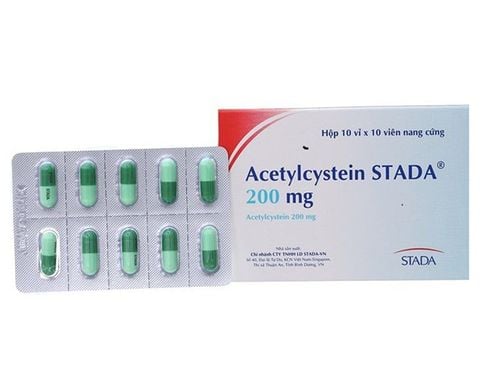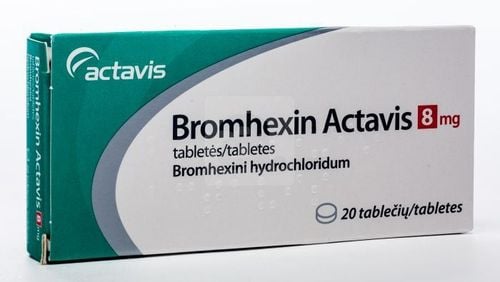This is an automatically translated article.
Xopenex is used in the treatment or prevention of people with reversible obstructive airways disease, including asthma and certain allergy-related breathing problems. The general information about the composition, uses, usage and side effects of Xopenex medicine will help patients improve treatment results.
1. Xopenex drugs:
Xopenex drug is prepared in 2 forms:
1.1. Xopenex (Levalbuterol hydrochloride) Prepared as a liquid for a nebulizer (nebulizer), a machine that converts liquid medicine into a mist that can be inhaled.
Content:
0.31 mg/3 ml; 0.63 mg/3 ml; 1.25 mg/3 ml; Xopenex is also available as a concentrated liquid solution: 1.25 mg/0.5 ml. This solution must be diluted before it can be made with a nebulizer. 1.2. Xopenex HFA (Levalbuterol tartrate) Preparation in an aerosol aerosol is accomplished using a dosing inhaler (an inhaler that releases jets of medication that can be inhaled).
Xopenex HFA comes in a 15g nebulizer box (each box contains 200 sprays). Each spray from the inhaler delivers 59 mcg of Xopenex HFA, equivalent to 45 mcg of Levalbuterol tartrate.
1.3. Mechanism of Action Levalbuterol aka Levosalbutamol is a beta2 adrenergic agonist, which activates receptors on airway smooth muscle tissue via Adenylate Cyclase activation to increase levels of Cyclic Adenosine Monophosphate (AMP). When the concentration of cyclic AMP increases, it activates Protein Kinase A, hinders the Phosphorylation of Myosin and reduces the concentration of Calcium in smooth muscle cells. The result is a reduction in smooth muscle and a reduction in the symptoms of bronchospasm. Levalbuterol dilates the airways from the trachea to the terminal bronchioles.
2. Uses of drugs Xopenex
Xopenex (Levalbuterol hydrochloride) is used to treat and prevent bronchospasm in people 6 years of age and older with reversible obstructive airways disease. Xopenex HFA (Levalbuterol tartrate) is used to treat and prevent bronchospasm in people 4 years of age and older with reversible obstructive airway disease. Reversible obstructive airway disease includes conditions such as bronchial asthma and certain other breathing problems related to allergies.
3. Contraindications of the drug Xopenex
Hypersensitivity to any ingredient in Xopenex. History of allergy to other medicines containing Levalbuterol hydrochloride or Levalbuterol tartrate.
4. Dosage and how to use Xopenex drugs
4.1. Xopenex (Levalbuterol hydrochloride) Dosage
People over 12 years: Nebulized 0.63 mg/time x 3 times/day (every 6 to 8 hours). The maximum dose of Xopenex is usually 1.25 mg/time x 3 times/day. People from 6 to 11 years old: nebulizer 0.31 mg/time x 3 times/day (every 6 to 8 hours). The maximum dose of Xopenex is usually 0.63 mg/time x 3 times/day. How to use:
Xopenex comes in the form of a liquid solution to be used with a nebulizer (nebulizer). With a nebulizer, the liquid medicine turns into a mist. After putting the Xopenex solution inside the nebulizer, place the nebulizer mask over the nose and mouth, then inhale the mist generated from the machine. It usually takes about 5 to 15 minutes for each treatment. Each nebulizer will have different instructions for use. Read the manufacturer's instructions for the machine to ensure efficient operation of the nebulizer. Children and the elderly need help setting up and using the nebulizer. 4.2. Xopenex HFA (Levalbuterol tartrate) Dosage:
People over 4 years old: 2 sprays (total 90 mcg)/time every 4 to 6 hours. How to use:
Xopenex HFA is in the form of an aerosol spray to be used with a metering inhaler (MDI). Breathe deeply and slowly after spraying to ensure that all of the medication is inhaled into the lungs. A metered inhaler (MDI) is often more difficult to use than a nebulizer.
5. Notes when using Xopenex drugs
Side effects encountered when using Xopenex
Treatment with Xopenex in high doses or for a long time, can cause side effects such as:
Allergic hypersensitivity: Skin rash, itching, flushing (hot and flushed) redness on the skin), more severe swelling may occur under the skin, usually in the eyelids, lips, hands or feet, swelling of the tongue/mouth or throat, difficulty breathing. Nervous system: Headache, dizziness, dizziness. Cardiovascular: Increased heart rate, increased or decreased blood pressure, palpitations. Respiratory: Upper respiratory tract infection causing cough, runny or stuffy nose, and sore throat. Shortness of breath, wheezing, chest tightness. Biochemistry: Hypokalemia causes fainting, tingling or numbness, muscle cramps, arrhythmia. Stop using Xopenex after detecting the above side effects or any other abnormalities. Patients and relatives should promptly inform their doctor or pharmacist about taking Xopenex or go to a medical facility for timely treatment.
Note the use of Xopenex in the following subjects:
Use caution when using Xopenex in people with a history of allergy to bronchodilators. People with a history of or are suffering from cardiovascular diseases, hypokalemia, diabetes. Pregnancy: According to the US Food and Drug Administration (FDA) classification of active ingredient Levalbuterol in group C, there is evidence of a risk on pregnancy. Therefore, the use of Xopenex in pregnant women should be limited unless its potential benefit outweighs the potential harm. Lactation: It is not known whether levalbuterol in Xopenex passes into breast milk. Women who are breastfeeding should talk to their doctor before deciding to use Xopenex. Drivers or machine operators may experience some side effects after using Xopenex.
6. Xopenex and Xopenex HFA drug interactions:
Interactions with other drugs
Using Xopenex or Xopenex HFA with Albuterol may increase your risk of serious side effects. Using diuretics such as Hydrochlorothiazide (Microzide), Furosemide (Lasix), Bumetanide (Bumex)... in combination with Xopenex or Xopenex HFA drugs can reduce blood potassium. Using Xopenex or Xopenex HFA with Beta-blockers such as Atenolol (Tenormin), Metoprolol (Toprol), Bisoprolol (Zebeta), Labetalol (Trandate)... may decrease the effectiveness of Xopenex or Xopenex HFA in reducing contractions. bronchial constriction. Using Xopenex or Xopenex HFA with Digoxin reduces the absorption of Digoxin thereby reducing the effectiveness of the treatment. The following antidepressants should not be taken at the same time or within 2 weeks of taking Xopenex or Xopenex HFA: Monoamine oxidase inhibitors (MAOIs) such as Selegiline (Emsam), Phenelzine (Nardil) Antidepressants tricyclics such as Amitriptyline, Desipramine (Norpramin), Nortriptyline (Pamelor). Above is basic information about ingredients, uses, doses and precautions when using Xopenex. In order to bring about the best treatment effect, patients and relatives should carefully read the instructions for use and strictly follow the treatment instructions of the specialist.
Please dial HOTLINE for more information or register for an appointment HERE. Download MyVinmec app to make appointments faster and to manage your bookings easily.













